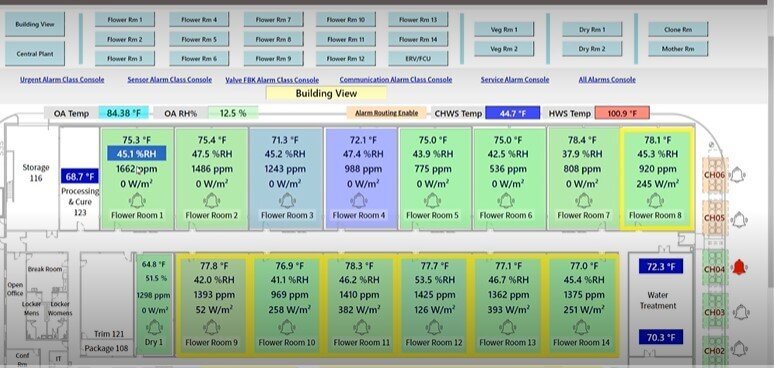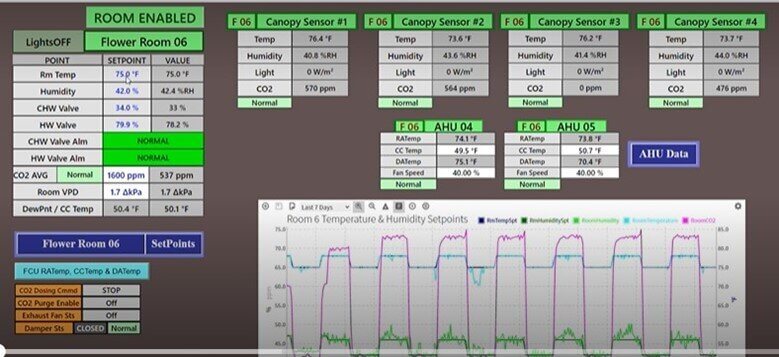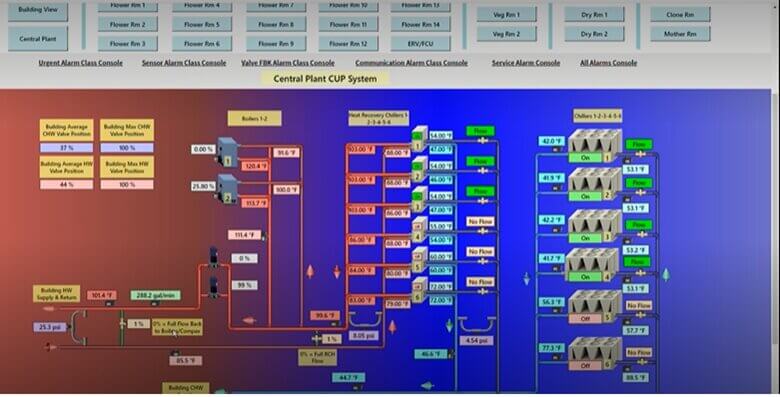Advantages of Implementing a 4-Pipe Chilled Water System
At Surna, being an expert in climate control for cultivation facilities means having expertise in every type of system that can be effectively applied in indoor and greenhouse growing. It requires us to know the benefits, challenges, and intricacies of the various technologies available and how their performances differ from one another in application, whether chilled water or DX, 4 pipe or 2 pipe, Hot Gas Reheat or VRF. We’ve designed and implemented them all, and they each have their own pros and cons. One of our primary responsibilities as your design partner is to understand the unique goals of the cultivator and help to recommend the type of approach that best fits those goals.
With that in mind, we thought it would be helpful to do an informational series with a look into a live facility utilizing the various technologies we’ve designed. For the first edition, we decided to skip right to one of the most challenging types of systems to design and implement, but one in which we are uniquely qualified: 4-pipe chilled water.
What is a 4 pipe chilled water system?
4 pipe chilled water works to heat, cool and dehumidify using a central piece of air handling equipment. Chilled water is circulated through the cooling coil for the purposes of cooling and dehumidification, and hot water is circulated through the reheat coil for the purposes of reheat in dehumidification applications, or ambient heating as needed. Fan speeds and valve positions are modulated to optimize results. Cold water is provided by high efficiency chillers (powered by gas or electricity), and heat can be provided via heat recovery from the chillers, high efficiency boilers, or even CHP.
In general, 4 pipe chilled water offers industrial quality equipment with longer life spans, outstanding precision, deep access to operational data, enormous flexibility placement and form factor of the various components, extremely versatile redundancy options, and in most cases reduces the connected electrical load required for climate control considerably. However, it is also complex to implement and correctly maintain. It requires specialized expertise that not all cultivators will have access to, and is among the most capital intensive types of systems to implement. 4 pipe chilled water typically is best applied in very large cultivation facilities, facilities with tight spatial constraints, where connected electrical load is a primary consideration, or where data analysis and operational precision is of primary importance.
Exploring the Cost Savings of 4-Pipe Chilled Water Systems
In the facility we’re looking at today, please see the Sentry IQ controls screen shot of an actual live facility below and note that the climate parameters in all rooms in the facility are very well maintained:

In the screenshot of a single room below, the precision of chilled water systems becomes apparent. Note the setpoints (controlled to an average of the 4 sensors in the room) and actual conditions on the left side of the screen:

In the screenshot of the chiller plant for this facility below, you will see the entire chilled water and hot water plant for the facility. Note the boilers and chillers that aren’t in active operation, which offer redundancy to the entire facility without the need to provide redundancy in each individual room. This also allows the load to be shared across multiple pieces of equipment, which keeps the equipment from running at full capacity 100% of the time, improving its overall longevity:

You can also see the depth and breadth of information that is available to the facilities maintenance team through the Sentry IQ controls system, which can be utilized both to optimize operation and to troubleshoot the system when service is needed. Sentry IQ is highly customized for the cultivation industry, and other controls systems will require a measure of sophistication to cause the system to respond appropriately to the conditions in the space. This volume of data is generally only available with chilled water systems, as with DX systems the primary functionality is internal to the DX unit, reducing the complexity for operators but also reducing the visibility and data available to them.
For a deeper dive, join two of our mechanical Professional Engineers, Ian Atkins (Applications Engineer) and Kenneth Loshelder (Director of Operations) as they do a live demo of the Sentry IQ controls system paired with 4 pipe chilled water in an actual cultivation facility.


